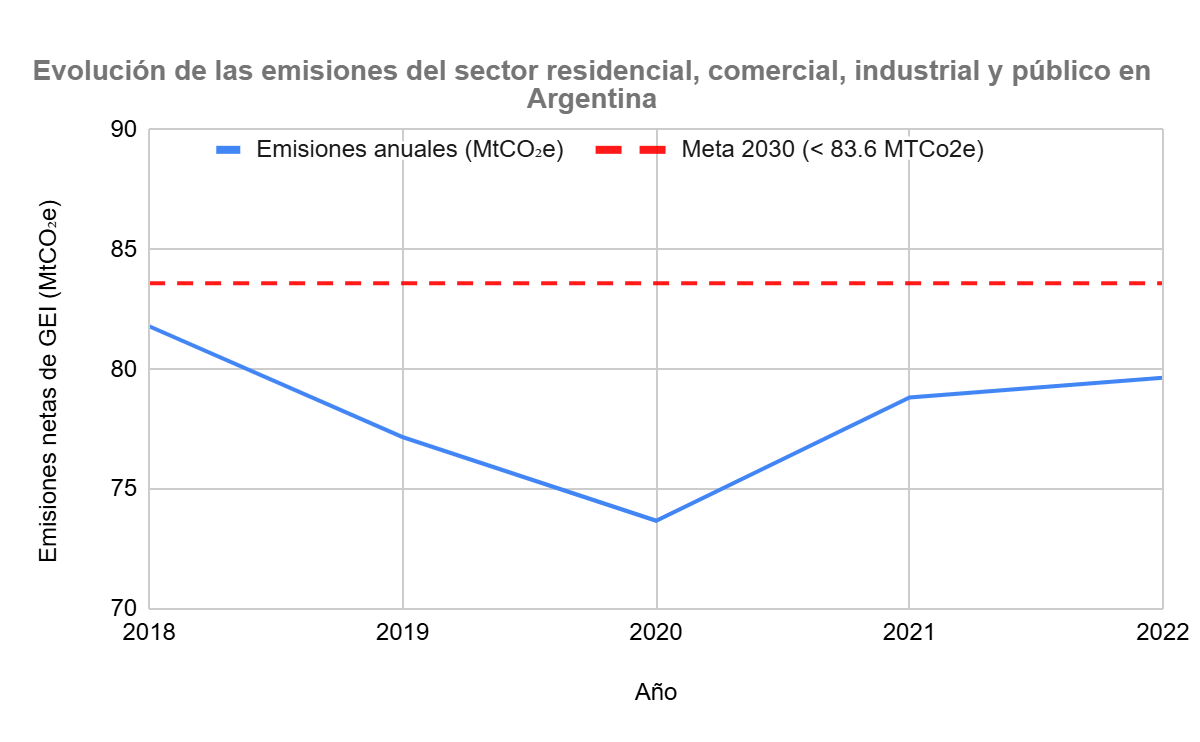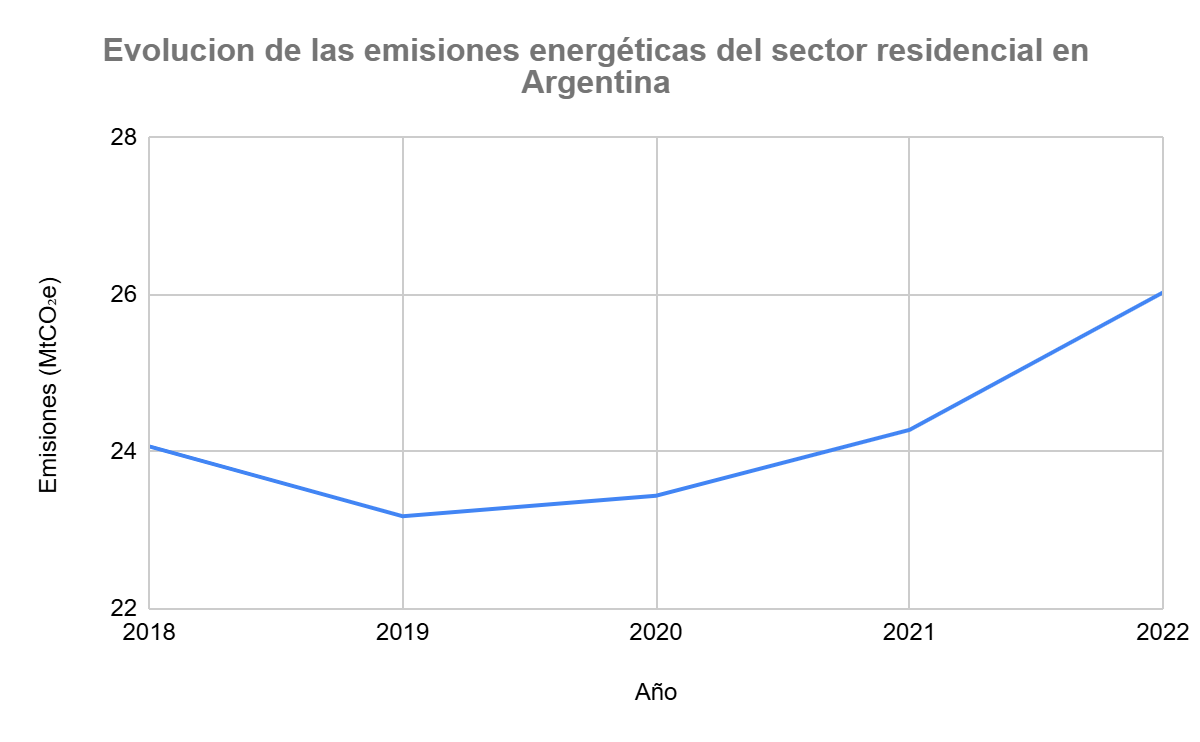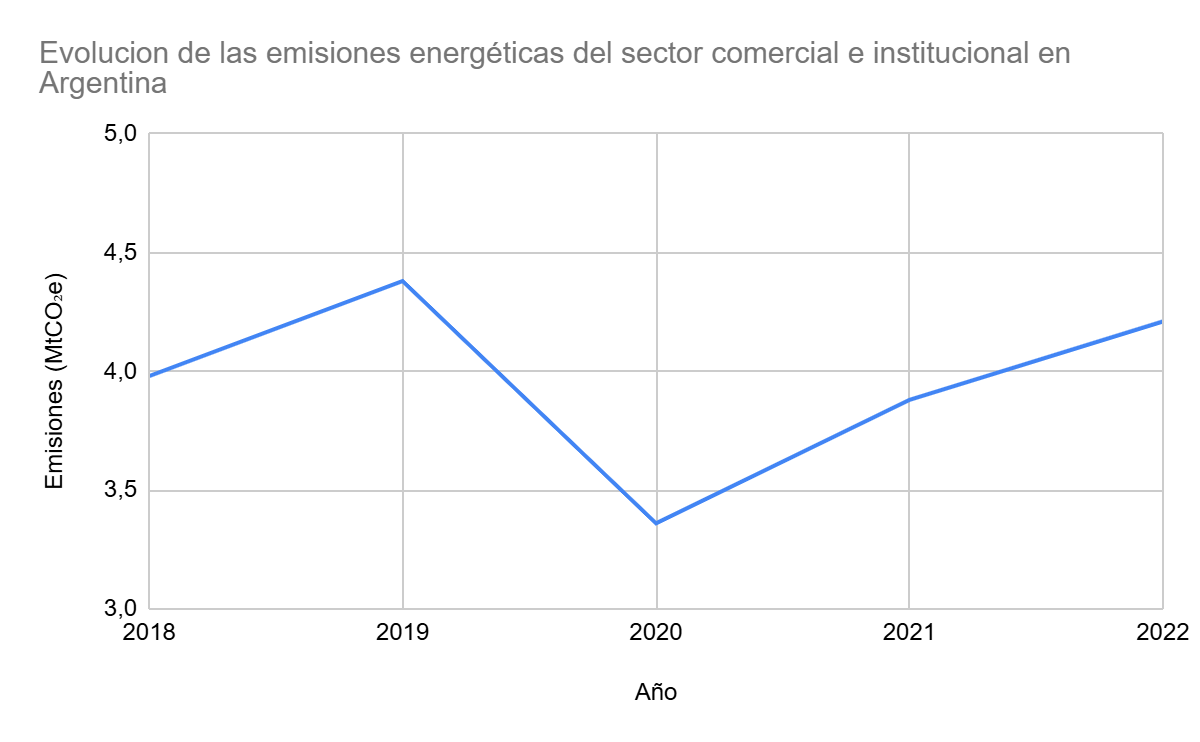11.3
Published onNet emissions from the residential, commercial, industrial, and public sub-sectors reached 79.65 MtCO₂e in 2022, according to the National Greenhouse Gas Inventory (INGEI 2024) and the First Biennial Transparency Report (BTR 2024). This value is below the sectoral objective set for 2030 (≤ 83.6 MtCO₂e) but with a very narrow margin and without clear signs of structural transformation that would support sustained compliance over time.
The historical series (see Figure 1) shows a significant drop in 2020 (73.68 MtCO₂e) attributable to the pandemic-related contraction in economic activity, followed by a gradual recovery in subsequent years. In 2022 the total reached 79.65 MtCO₂e with differing behavior across sub-sectors. In the residential sub-sector (see Table 2), emissions rose from 24.07 MtCO₂e in 2018 to 26.03 MtCO₂e in 2022, indicating an upward trend associated with increased energy demand for thermal uses and the low penetration of clean technologies such as distributed renewables or efficient electric heating systems. In the industrial sub-sector (see Table 3), which accounts for over 60% of the aggregate total, there was an initial reduction (due to the drop in activity in 2020) but emissions have stagnated since 2021, with no evidence of sustained improvements in efficiency or technological substitution. Meanwhile, the commercial and institutional sub-sector (see Table 4) shows a more contained pattern, with emissions moving from 3.98 MtCO₂e in 2018 to 4.21 MtCO₂e in 2022, including a marked decline in 2020 (3.36 MtCO₂e) due to health restrictions and a subsequent gradual recovery. Overall volumes remained relatively low and stable, without relevant structural changes or evidence of shifts toward more sustainable energy-consumption models.
Regarding sectoral policies, the First Progress Report of the Second National Plan for Adaptation and Mitigation to Climate Change (2024) identifies a set of relevant measures but notes serious limitations in their implementation and tracking. Particularly noteworthy is the status of energy-efficiency programs, which currently lack an operational national implementing authority—hindering progress assessment and limiting their ability to scale (p. 93). Many key measures—such as electrification of thermal end uses, home energy labeling, efficiency improvements for SMEs, or the promotion of distributed renewable generation—remain in pilot phases without defined timelines, sustained financing, or public monitoring of results. Although some sectoral agencies reported formal advances, there is no concrete evidence of emissions reductions attributable to these policies.
Against this backdrop, while the 2022 value suggests partial compliance with the objective, the sector cannot be considered aligned with a robust decarbonization pathway. The risk of reversal is high, especially in the residential sub-sector where thermal consumption and the lack of building efficiency could continue pushing emissions upward. The industrial sub-sector, with its large relative weight, requires deep technological transformations and more ambitious efficiency policies to sustain structural reductions.
A further critical limitation concerns the availability of information. The progress report does not include updated data for 2024, nor does it present a set of indicators enabling year-to-year tracking of sector performance. There is no public, disaggregated, and systematic information on the progress of measures, their real impacts, or the degree of territorial implementation. This lack of transparency and verifiable data weakens the ability to monitor compliance, identify deviations, and adjust policies in a timely manner.
In sum, although the sector reached in 2022 an emissions level compatible with the 2030 objective, there are no guarantees of sustainability over time given recent trends and weaknesses in policy implementation. The current outcome is therefore classified as limited progress, conditioned by the absence of a structural decline trajectory and the insufficiency of the institutional and technical scaffolding needed to sustain compliance.
Figure 1. Evolution of GHG emissions in the residential, commercial, industrial, and public sub-sectors in Argentina (2018–2022)
Source: Sol Lofeudo (2025), based on data obtained from the interactive platform of the National Greenhouse Gas Inventory and Mitigation Measures Monitoring (INGEI, 2024). Work prepared for Latam Lab (2025).
Figure 2. Evolution of GHG emissions in the residential sector in Argentina (2018–2022)
Source: Sol Lofeudo (2025), based on data obtained from the interactive platform of the National Greenhouse Gas Inventory and Mitigation Measures Monitoring (INGEI, 2024). Work prepared for Latam Lab (2025).
Figure 3. Evolution of energy-related GHG emissions in the industrial sector in Argentina (2018–2022)
Source: Sol Lofeudo (2025), based on data obtained from the interactive platform of the National Greenhouse Gas Inventory and Mitigation Measures Monitoring (INGEI, 2024). Work prepared for Latam Lab (2025).
Figure 4. Evolution of energy-related GHG emissions in the commercial and institutional sectors in Argentina (2018–2022)
Source: Sol Lofeudo (2025), based on data obtained from the interactive platform of the National Greenhouse Gas Inventory and Mitigation Measures Monitoring (INGEI, 2024). Work prepared for Latam Lab (2025).
Table 1. Historical series of GHG emissions from the residential, industrial, commercial, and public energy sub-sectors in Argentina (2018–2022)
Source: Sol Lofeudo (2025), based on data obtained from the interactive platform of the National Greenhouse Gas Inventory and Mitigation Measures Monitoring (INGEI, 2024). Work prepared for Latam Lab (2025).
Table 2. Historical series of GHG emissions from the residential energy sub-sector in Argentina (2018–2022)
Source: Sol Lofeudo (2025), based on data obtained from the interactive platform of the National Greenhouse Gas Inventory and Mitigation Measures Monitoring (INGEI, 2024). Work prepared for Latam Lab (2025).
Table 3. Historical series of GHG emissions from the industrial energy sub-sector in Argentina (2018–2022)
Source: Sol Lofeudo (2025), based on data obtained from the interactive platform of the National Greenhouse Gas Inventory and Mitigation Measures Monitoring (INGEI, 2024). Work prepared for Latam Lab (2025).
Table 4. Historical series of GHG emissions from the commercial and institutional energy sub-sector in Argentina (2018–2022)
Source: Sol Lofeudo (2025), based on data obtained from the interactive platform of the National Greenhouse Gas Inventory and Mitigation Measures Monitoring (INGEI, 2024). Work prepared for Latam Lab (2025).
References
-
Ministry of Environment and Sustainable Development. (2022). Long-Term Strategy for Low-Emission, Climate-Resilient Development to 2050. Government of the Argentine Republic.
-
Secretariat of Energy. (2023). National Energy Transition Plan to 2030. Ministry of Economy, Government of the Argentine Republic. (IF-2023-70145558-APN-SSPE#MEC).
-
Undersecretariat for Environment. (2024). National Greenhouse Gas Inventory: First Biennial Transparency Report. Argentina 2024 (ISBN 978-631-00-6500-7). Secretariat for Environment, Tourism and Sports, Office of the Deputy Chief of Staff for the Interior.
-
Undersecretariat for Environment. (2024). First Progress Report: Implementation of the Second National Plan for Adaptation and Mitigation to Climate Change. Ministry of Environment and Sustainable Development, Government of the Argentine Republic.
-
Undersecretariat for Environment. (2024). National GHG Inventory – Interactive results platform. Ministry of Environment and Sustainable Development. https://inventariogei.ambiente.gob.ar/resultados




